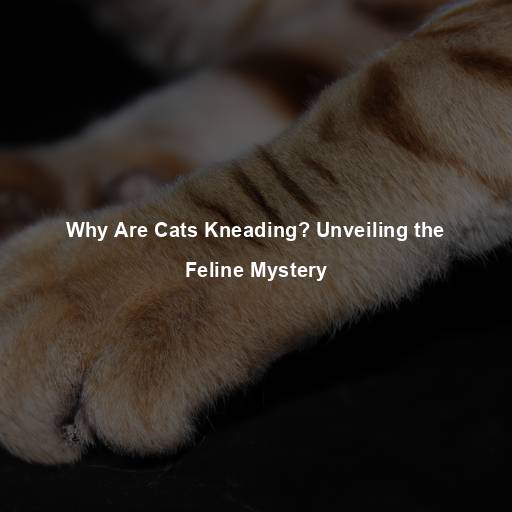How Do Cats Hiss? Understanding the Language of Feline Communication
Last Updated on October 27, 2023 by Evan
Contents
Exploring the Intricate World of Feline Communication
Cats, those captivating beings that tantalize our curiosity with their enigmatic ways, possess a peculiar form of communication known as hissing. It is within the realm of this vocal manifestation that cats reveal their innermost thoughts and emotions to us and their feline counterparts. But why does a cat choose to hiss? Join us on a journey into the depths of feline communication as we unravel the perplexing power and purpose behind the haunting sound of a cat’s hiss.
The Basics of Cat Communication
Before we dive into the specifics of hissing, it’s essential to grasp the fundamentals of how cats communicate. Cats use a combination of vocalizations, body language, and scent marking to express their emotions and intentions. By understanding these signals, we can decipher what our feline companions are trying to convey.
Vocalizations
Cats possess an intriguing ability to unleash a symphony of distinctive vocal expressions, each imbued with its own profound significance. From the comforting cadence of a gentle purr to the persuasive urgency of a formidable meow, these sonic manifestations convey their intricate message to not only humans but also their fellow creatures. Yet, amidst this harmonious repertoire, the enigmatic hiss sets itself apart, evoking a sense of mystifying divergence from the feline vocal universe.
Body Language
Feline body language is a fascinating aspect of their communication repertoire. Through their posture, facial expressions, tail movements, and ear positions, cats can convey a wealth of information. Understanding these non-verbal cues can aid in interpreting a cat’s mood and intentions accurately.
Scent Marking
Did you know that cats have a secret language of scent? These fascinating creatures use their cheeks, paws, and tails to leave behind subtle messages for other feline friends. You might have noticed them rubbing against objects or giving a good scratch – that’s their way of communication through scent marking. But here’s a twist: hissing, on the other hand, has a different purpose altogether and doesn’t involve any sneaky scents!
What is Hissing?
The Sound and Posture of a Hiss
Cats have this uncanny ability to communicate their unease and discomfort through an unmistakable vocalization known as hissing. When they sense a threat, their mouths release a sharp and intense sound, leaving no room for misinterpretation. This distinct noise is complemented by a particular body posture, creating a perplexing display of feline self-expression.
When a cat hisses, it arches its back, raises its fur, and may even stand on tiptoes to appear larger and more intimidating. The ears are usually flattened against the head, and the tail may be lashing back and forth aggressively. The combination of these physical signs with the hissing sound sends a clear message of warning to the perceived threat.
The Purpose of Hissing
Cats have a knack for theatrical self-defense – their secret weapon? Hissing. This seemingly strange sound is their way of saying, “Hey, hold your horses, I’m not thrilled with this situation”! Hissing serves as a clever deterrent, warding off potential threats and sending a clear message – “you better think twice before messing with me”.
Hissing can occur in various situations, such as when a cat encounters a new animal, feels cornered, or experiences excessive stress. It acts as a warning signal, indicating that the cat is ready to defend itself if necessary. Understanding why cats hiss can help us respect their boundaries and provide a safe environment for them.
Decoding the Message Behind a Hiss
Fear and Anxiety
It’s no secret that cats have a few tricks up their furry sleeves, and hissing is one that often leaves perplexed owners scratching their heads. This burst of sound, resembling a snake’s warning, is a cat’s way of communicating their fear or anxiety. Whether faced with a new pet, a trip to the vet’s office, or unknown surroundings, hissing becomes their defensive shield, a desperate attempt to protect themselves and maintain a safe distance. So next time your feline friend unleashes a hiss, remember, it’s not personal; it’s their way of saying, “Back off”!
Protecting Territory
Cats, those enigmatic beings of the animal kingdom, possess an innate sense of territorial prowess that borders on the mystical. When faced with an intrusion into their sacred domain, whether it be from a fellow feline, a curious canine, or even an audacious human, they unleash a symphony of sound that sends shivers down the spine – the powerful hiss. With each hiss, they declare with unwavering conviction, “Back off, intruder! This territory is mine, and mine alone”.
Pain or Aggression
In the fascinating realm of feline behavior, the enigmatic art of hissing takes center stage, leaving both cat owners and admirers alike captivated by its hidden message. When the mysterious creature succumbs to pain or finds itself embroiled in a fiery encounter, a hiss may escape its velvety lips, serving as a warning siren for all to hear. It is in these intricate moments that we must decipher this feline language, respecting their boundaries and granting them the solace they require until tranquility reigns once more.
How to Respond to a Hissing Cat
When you come face to face with a cat emitting a hiss, it is crucial to react in a manner that safeguards your own welfare as well as the cat’s overall health. To navigate this prickly situation, here are some handy guidelines to bear in mind when you encounter a feline issuing forth a hissing sound:
-
Remain calm: It’s natural to feel startled or fearful when a cat hisses, but it’s crucial to remain composed. Cats can sense fear and may become even more agitated if they perceive you as a threat.
-
Give space: Respect the cat’s boundaries and give it ample space. Do not attempt to touch or approach the cat until it has calmed down.
-
Avoid direct eye contact: Staring directly at a hissing cat can be seen as a challenge or threat. Instead, glance away occasionally to show that you mean no harm.
When it comes to communicating with our feline friends, it’s important to approach them with a gentle and reassuring demeanor. By speaking softly and using a calm tone of voice, we can help alleviate any anxiety or tension that the cat may be feeling. It’s also essential to be mindful of our movements and avoid any sudden actions or loud noises that could potentially startle or intimidate them. Building trust and creating a peaceful environment is key to fostering a positive and harmonious relationship with our furry companions.
- Allow escape routes: Ensure that the cat has an opportunity to retreat to a safe space if it desires. Blocking its escape route may increase its stress levels and prolong the hissing behavior.
Seeking professional guidance can be a valuable step if your feline friend’s hissing behavior continues or intensifies. Veterinarians and animal behaviorists possess the expertise to provide tailored advice based on your unique circumstances. Don’t hesitate to reach out to these knowledgeable professionals for the purrfect solution to your cat’s perplexing hissing behavior.
Understanding the Role of Socialization
Understanding the important role socialization plays in a cat’s behavior is essential. Early exposure to different people, animals, and surroundings molds their communication skills and fosters adaptability. Cats who are well-socialized tend to handle new or unfamiliar situations without resorting to hissing as a defensive tactic. This knowledge empowers cat owners to prioritize socialization for their furry friends, ensuring a more harmonious and fulfilling feline-human relationship.
Encouraging Positive Socialization
Building a strong foundation for your feline friend’s social development is crucial for their overall well-being. By exposing them to diverse socialization experiences during their formative years, you can nurture their confidence and adaptability. Here are some valuable insights to assist you in this journey, ensuring a harmonious and fulfilled life for your beloved cat.
-
Introduce new experiences gradually: Gradual exposure to different people, animals, and environments allows your cat to acclimate without feeling overwhelmed.
-
Reward positive behavior: When your cat displays calm and relaxed behavior in new situations, reward them with treats, praise, or playtime. This positive reinforcement helps create positive associations.
Create cozy havens for your feline companion by providing them with a range of safe spaces to escape to, whether it’s tucked away hiding spots or elevated perches. These sanctuaries give your cat the reassurance they need to navigate the world with confidence and peace of mind.
- Enlist the help of professionals: If you’re unsure about the best approach to socializing your cat, consider consulting with a professional behaviorist or trainer who specializes in feline behavior.
Misconceptions About Hissing
Hissing Does Not Equal Aggression
It is essential to understand that hissing does not always indicate aggression in cats. While hissing is a defensive vocalization, it is not necessarily an indicator that the cat intends to attack. Cats often resort to hissing as a warning, hoping to avoid physical confrontation. It is their way of saying, “I’m not comfortable with this situation, please back off”.
Not All Cats Hiss
When it comes to hissing, it’s important to remember that not all cats embrace this particular form of expression. Each feline has their own distinct personality, some more tranquil than others, opting for alternative means of communication to convey their unease or dissatisfaction. To truly comprehend your cat’s communication style, make sure to observe their body language and listen closely to the range of vocalizations they use.
Hissing Does Not Mean a Cat is “Mean”
When it comes to our feline friends, it’s crucial not to hastily slap on derogatory stickers like “mean” or “aggressive” when their hissing comes into play. Those hisses, believe it or not, are their way of self-preservation, an inbuilt defense mechanism. Grasping the intricate motivations behind these hisses allows us to navigate their intentions smoothly, averting any chances of misconstruing their gentle souls.
Additional Forms of Feline Communication
Purring
When it comes to the fascinating world of feline communication, there’s one distinctive sound that stands out above the rest: purring. This enigmatic vocalization seems to embody a whole spectrum of emotions for our beloved furry friends. From pure contentment to a yearning for solace, the gentle hum of a cat’s purr holds the key to unlocking their innermost feelings. Yet, amidst this symphony of tranquility, a conundrum arises – for cats, purring can be a signal of both bliss and discomfort.
Meowing
Cats have unlocked the secret to getting what they want from us humans – meowing! This peculiar vocalization seems to hit the right buttons, summoning a response from their ever-attentive servants. But don’t be fooled by its simplicity, as meows are a complex language in feline society. From craving a tasty snack to craving some quality cuddle time, these furry masters of communication have mastered the art of manipulating our hearts through the perfect pitch, tone, and duration of their meows.
Body Posture and Facial Expressions
When it comes to feline communication, cats have mastered the art of unspoken language. Through a symphony of ear positions, eye movements, tail flicks, and overall body language, these enigmatic creatures express a vast spectrum of emotions. Picture a blissed-out kitty with half-closed eyes, gently swaying tail, and alert ears pointing forward, radiating contentment. In stark contrast, an anxious or fearful feline might flatten its ears, widen its pupils, and assume a rigid stance.
Scent Marking and Rubbing
Did you know that our feline friends have an intriguing way of communication? Cats possess scent glands scattered across their body which they cleverly utilize for marking their territory or expressing familiarity. By engaging in a unique behavior of rubbing against objects or even individuals, they leave behind their distinct scent as a form of asserting ownership or offering a warm greeting. This burst of intriguing information sheds light on the fascinating world of our enigmatic companions.
FAQs – How do cats hiss?
What does it mean when a cat hisses?
When a cat hisses, it is a clear indication that the cat feels threatened or fearful. Hissing is a defensive behavior that cats use to communicate their discomfort or to ward off potential threats. The sound of a hiss is produced when a cat forcefully exhales air through a partially closed mouth, creating a sharp “sss” sound. It is a warning signal to other animals or humans to keep their distance.
Why do cats hiss at humans?
Cats may hiss at humans if they perceive a threat or feel stressed. It can happen when a cat is being approached too quickly, handled in a rough manner, or when they are scared or feeling cornered. Hissing serves as a way for cats to express their unease and attempt to deter any further actions that make them feel uncomfortable. It is essential to respect a hissing cat’s boundaries and give them space to calm down.
Can cats hiss at other cats?
Yes, cats can certainly hiss at other cats. Hissing is commonly observed when two cats are in conflict or are trying to establish dominance. It is a way for them to communicate their discomfort or assert their boundaries. Hissing can also be seen during territorial disputes or when unfamiliar cats encounter each other. It’s important to note that hissing in these situations is often seen as a temporary warning and does not always escalate into aggression.
Should I be concerned if my cat hisses frequently?
Is your feline companion unleashing a symphony of hisses? Don’t just brush it off as harmless noise – it could be a cry for help! The persistent hissing might be a red flag, signaling chronic stress or deep-rooted fear. But don’t fret, dear cat lover, for there might be a way to unravel this mystery. Observe your furry friend closely, for clues lie in their behavior. Could it be a change in their environment, an anxiety-ridden mind, or even a past traumatic encounter? If this hissing is accompanied by other distressing or aggressive behaviors, it’s time to bring in the experts – your trusty veterinarian or a knowledgeable animal behaviorist will lend a helping paw.
How can I help my cat stop hissing?
Understanding and resolving the hissing predicament of your feline friend requires a nuanced approach. Delving into the depths of their fears and discomfort will unearth the key to soothing their troubled hearts. Craft a haven of serenity and security for your kitty, complete with hideaways where they can seek solace during their anxious moments. Nurture a harmonious routine that offers both mental stimulation and physical activity. Ingraining trust through the power of positivity and slow-paced socialization is an art worth mastering. However, do not hesitate to consult a professional if the hissing persists or escalates, as their expertise can provide valuable insights.






